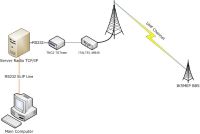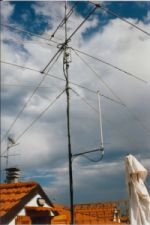Second station
| Address | Via A. Ceri 3 59100 Prato (PO) |
| WWLocator | JN53MV |
| Timeframe | August 1994 February 2005 |
| HF Radio | Kenwood TS 940S/AT Icom IC 756-pro |
| HF Antennas | Hy-Gain TH3 3el 10/15/20 Vertical for 40m e dipoles for WARC |
| VHF Radios | Kenwood TM732 Kenwood TH77 Icom IC-271A Icom IC-820 Italtel MB45 |
| VHF Antenns | Vertical V/UHF Tagra 10 el. VHF |
| Accessories | TNC KAM All Mode Packet Tnc and modem Some computers |
The Packet radio era
In 1994 I moved in a new house, still in the city of Prato: again it was an apartament, but the new building had several advantages (from the radio point of view) than the old one. First, it was on the top floor with lot of space for my shack; then, I had a direct access to the root with a big balcony on the top floor. It was a real pleasure to have no more than 10 meters of coax cable (just the height of the antennas)
I still wasn't able to install a tower due to lack of money, so I had to use again simple poles to take my loyal TH3 and some other thing I bought in the meanwhile. Together with my father, we ensembled a cage for the rotaror, so I can add to the mast also the VHF yagi avoiding any arm to the rotor itself (by the way, that motor is still up and running today after more than 15 years of service).
Of course, all that glitters is not gold: the new house has at least two problems:- It was at the end of Bisenzio Valley: Prato, my city, is a windy place on its own, but my house was located in the worst position (other hams near me, with bigger antennas, had some serious troubles due to wind). You can imagine my feelings on windy days (and, in Prato, you get wind at least three days a week!).
- On the roof there was no enought space for the 40 meters dipole: the V-inverted dipole ended near the roof which was made of reinforced cement, thus the antenna was not reactig too well!
Althought these minor issues, my interests were looking torwards a different world, specifically the packet radio: in those years, Internet and email were not so widely known and the only communication networks for home users were the phone BBS, but it was quite expensive because you have to pay both for the device (modem) and for the telephone call to the BBS (which often was in another city). Packet radio was a valid alternative for radio operators: years before email, an ham operator could send electronic mail messages all over the world relying only on radio path and networks (there were some station relaying mails on HF to reach other continents as well as satellite gateways); also, you could also download software using the well known YAPP program and protocol. At the beginning, my friend in this adventure was the KAM TNC.
Packet become quickly my main job in radio: since I had no way to setup a BBS or another type of automatic station on my own (I had only one
PC at the beginning: it was the time of Qemm and DeskView to have some kind of DOS multitasking ), I got involved in managing a local BBS owned
by IK5MEP.
Then, afer some years, I discovered another interesting world: the TCP/IP. Phil Karn, KA9Q, developed a software to put TCP/IP protocols on
a radio channel using AX.25: altought for many years I had those software installed on my computer (I own a dedicated IP address, 44.134.208.143
which is ik5pwc.ampr.org), I never played long with it because ... I didn't understand anything of it! I didn't understand why those IP numbers stands
for, what ARP was, why there was a subnet mask and so on..
I became interested when I discovered that you can use Internet-like software (typically, a browser and an email client, running still on
Windows 3.11) on a radio channel like it was an internet connection (of course, only with other amateurs, not really with the Internet which
begun to spread). It was IK5PVX, one of the Tuscany pioneer in TCP/IP, to show me the light!
In few days I assembled a spare PC, on which I installed and configured the JNOS software for TCP/IP operation: this "server" was linked
using a radio channel to the IK5MEP BBS (the one I was co-sysop) which I used to download ham bullettins. This system was online only few hours
a day because my parents didn't like to have a pc powered on all the day (mainly for security and cost reason).
This server (hostname tng.ik5pwc.ampr.org - 44.134.210.17) was then linked, using a serial line with the SLIP protocol, to my main computer
where I used internet-like software (specially the fantastic Netscape suite - browser and mail client) to read hamradio bullettins: I also
created some WEB pages, available to other hams using TCP/IP and a browser, of course using a radio channel.
One of the beautiful items in my TCP/IP server was the transceiver used to link with IK5MEP BBS: it was an Italtel MB45, one of the
first mobile phones in Italy, which I modified to be used as an UHF RTX (using the computer parallel port to program the frequencies):
link speed was 1200 bps (of course, half duplex!) which was a good speed for those ages!
I played for many years with this digital network: of course, I did some enhancement, starting to the link between the "server" and my PC which became an ethernet instead of a SLIP line; I still remember the difficulties I encountered trying to setup my first coaxial ethernet network (by the way, network adapters were not cheap in 1996/7!).
Things changed after some years (2002/2003), since Internet and home high-speed networks became so widely diffused so that a 1200 bps link appeared a little outdated, also because AX.25 was not deployed to carry TCP/IP protocols and thus is not very efficient. But the main reason is that towards the end of the century (1998 - 1999) I got involved in my job starting to work with real TCP/IP networks (in the meanwhile I understood the TCP!).

The new HF transceiver
So I closed out all my "digital" services and network and went back to the typical ham radio activity which is to contact other amateurs using any kind of mode/band. My interest in digital networks are now really satisfied by my job and my home servers (one of the is currently hosting this site). Based on this new interest, I bought my second HF RTX: an Icom IC-756PRO.
A final note: this station has also been hit (althought partially) by a lightning! Luckily, all radios were completely unplugged so I did not suffer big damages (only a modem and a PC power supply). All the antennas (except the VHF vertical which was on the top of the mast) weren't damaged and are currently "up and running".



